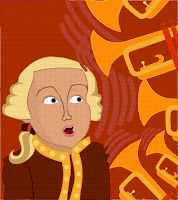
W.A. Mozart was an incredibly talented composer and performer. Check out these interesting facts about his musical life.
• Composer Wolfgang Amadeus Mozart was a musical child prodigy. As a child, he could play keyboard instruments better than most adults. He was an excellent sight-reader and fortepiano player and performed for many nobles throughout Europe.
• Until he was almost ten years old, Mozart was very afraid of horns. Once, when he heard a blaring trumpet, he grew pale and almost fainted!
• Nannerl, Mozart’s older sister, was also good at playing the piano. When they were young, Wolfgang and Nannerl played many duets together.
To learn more, visit Alberti Publishing.
Illustration by Heidi Cabrera.
________________________________________________________________










